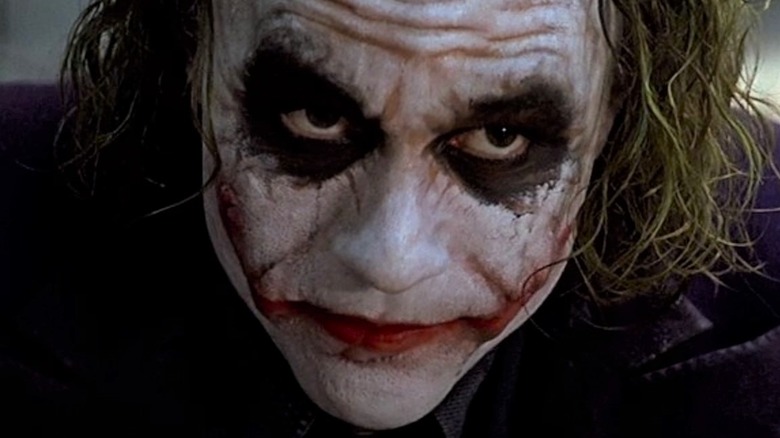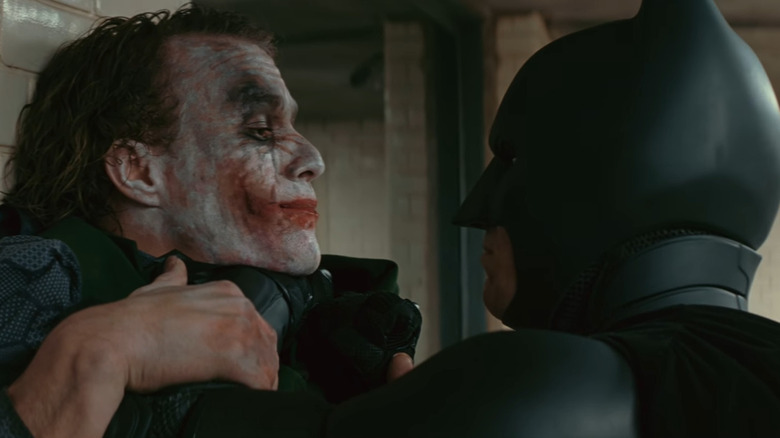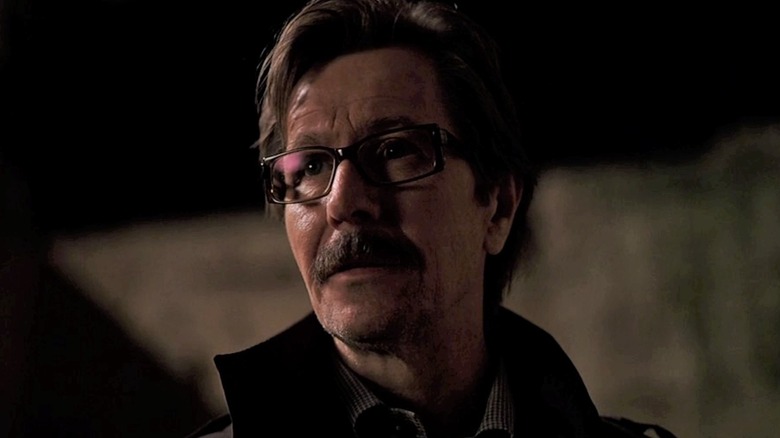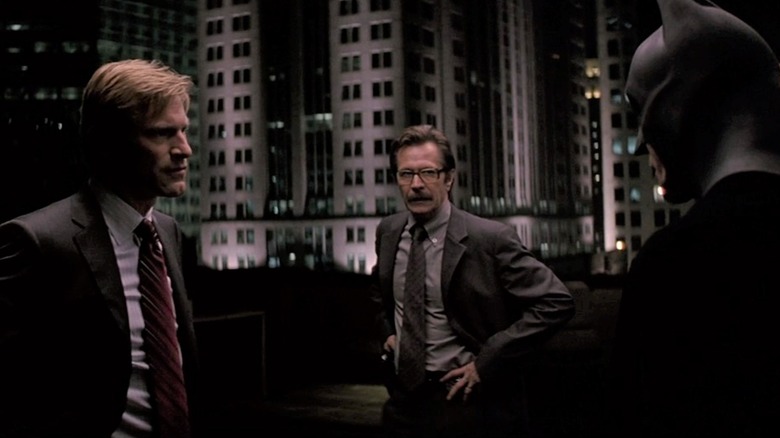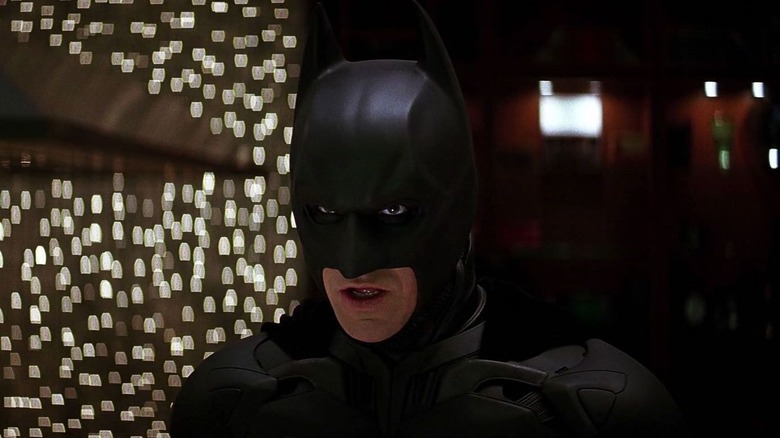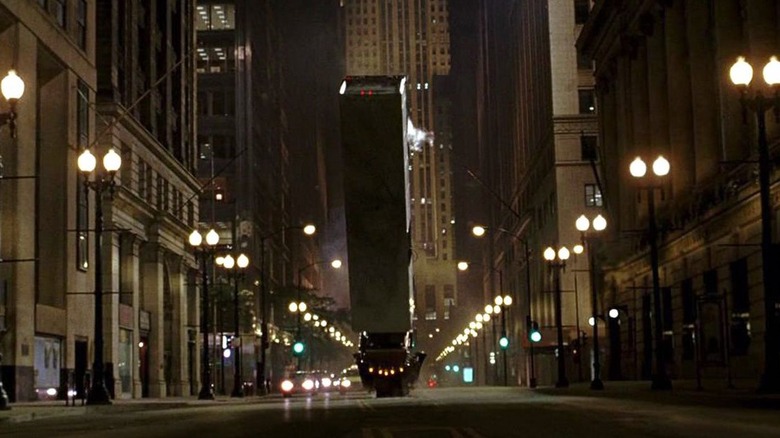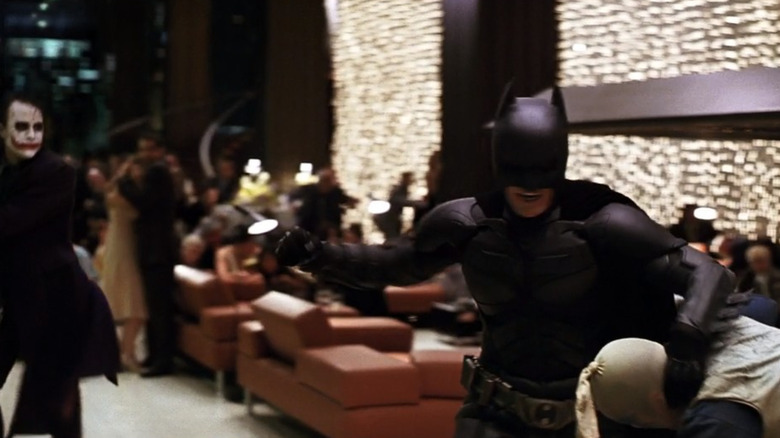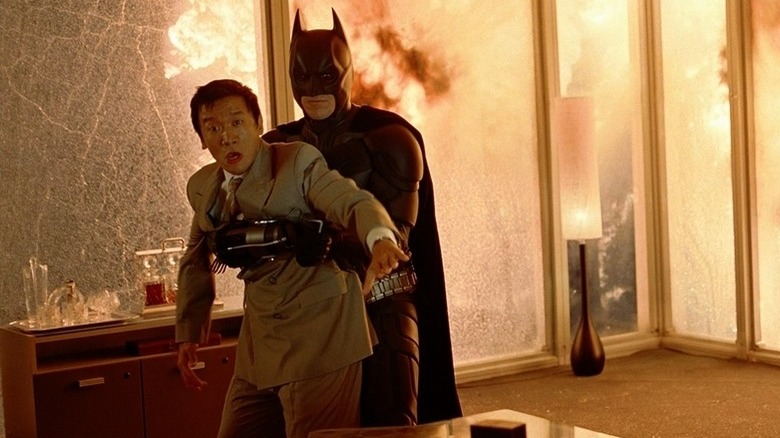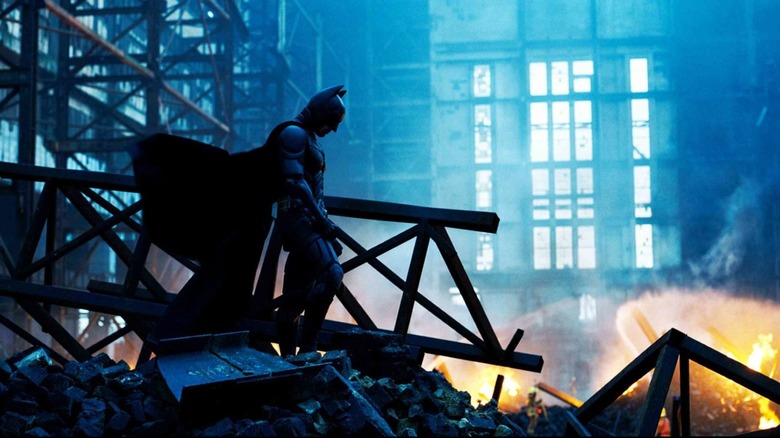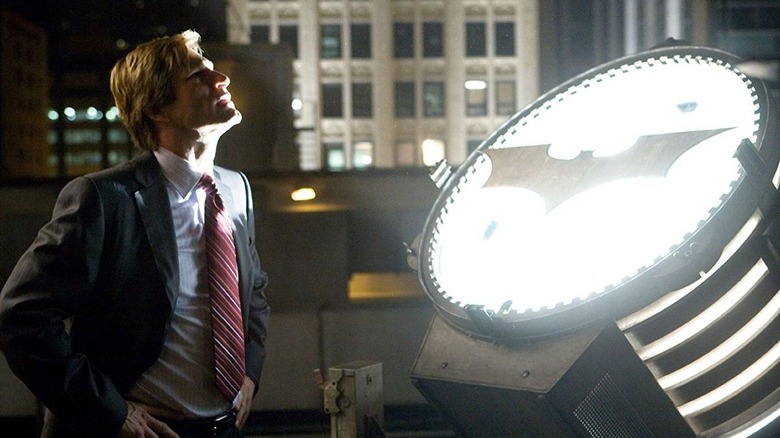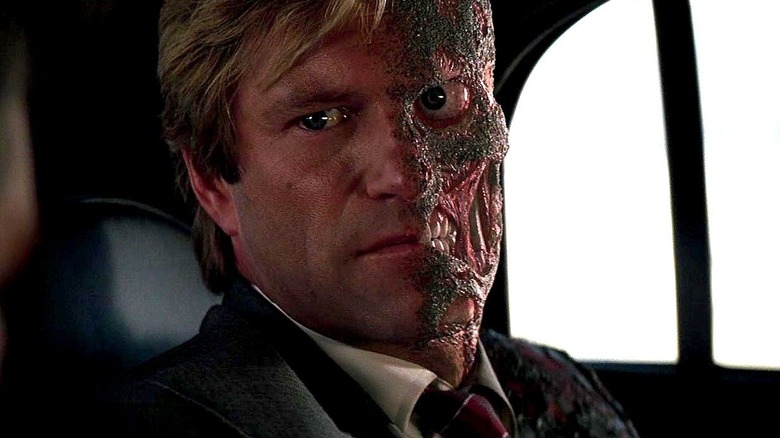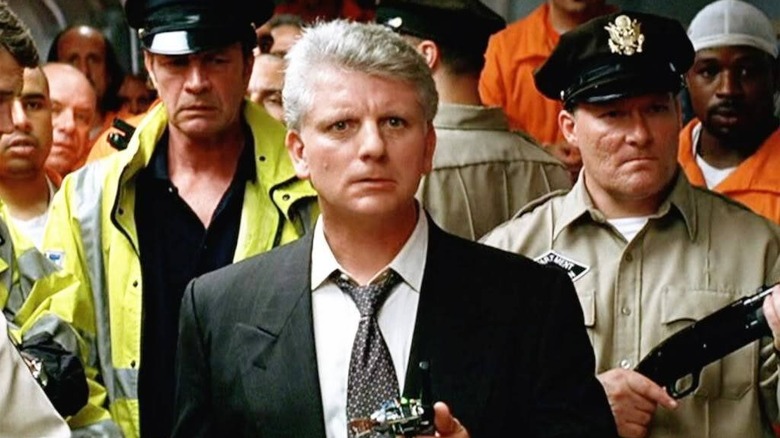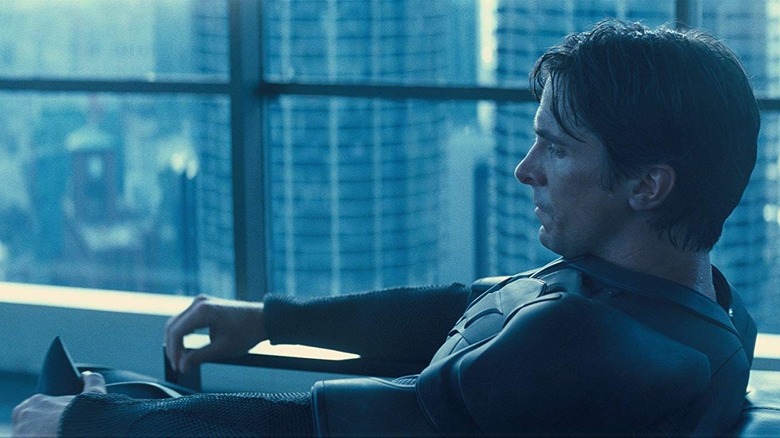The 6 Best And 6 Worst Things About The Dark Knight
In the annals of superhero cinema, 2008's "The Dark Knight" remains in a class of its own. Not only did the movie make a killing at the box office, but it also won over critics and award show committees in a way that superhero films had never done before. Praise was aimed at the film for not just being great popcorn entertainment but also an ambitious work of cinema.
The movie tells the story of Bruce Wayne/Batman as he searches for a way to stem the flood of corruption in Gotham City once and for all. Bruce is helped in his quest by charismatic district attorney Harvey Dent, who shares his rigid sense of justice. But not even the combined might of the two men can withstand the psychological onslaught of the Clown Prince of Crime, the supervillain known as the Joker.
Much of the praise directed at "The Dark Knight" went to Heath Ledger for his once-in-a-lifetime performance as the Joker, for which he won a posthumous Oscar for best supporting actor. "The Dark Knight" director Christopher Nolan was also showered with plaudits for grounding a superhero saga in something resembling the real world with three-dimensional characters and believable stakes. But as good as the movie is, it's still not perfect and has its fair share of flaws. Let's take a look at some of the best things about "The Dark Knight," as well as the worst.
Best thing: Heath Ledger's performance
While superhero fans have a variety of opinions regarding their favorite movie in the genre, one thing most agree on is that Heath Ledger's Oscar-winning performance as the Joker in "The Dark Knight" set the gold standard against which all future superhero movie performances would be measured.
It's strange to consider that many "Batman" fans absolutely hated the idea of Ledger playing the Joker when the casting was first announced. But that attitude changed quickly when Ledger revealed himself at the start of "The Dark Knight." The guttural voice, the twitching face, the deadpan stare, and the sudden bursts of hysterical laughter — Ledger took the Joker from the comics and brought him into the real world in a manner that was as fascinating as it was terrifying to watch.
Since that time, many comic book movie actors have referenced Ledger's Joker as a source of inspiration in their own work, like Michael B. Jordan's take on Erik Killmonger. Ironically, the only other actor to win an Oscar for portraying a superhero movie character was Joaquin Phoenix playing a different version of the Joker in 2019. And even Phoenix acknowledged the influence of Heath Ledger's performance during one of his acceptance speeches.
Worst thing: Too many plotlines
"The Dark Knight" clocks in at a pretty cumbersome total runtime of 2 hours and 32 minutes. That is a whole lot of movie to get through, especially for a blockbuster designed to be enjoyed as "popcorn fare" by audiences with increasingly limited attention spans. "The Dark Knight" needs all that time because it's not a straightforward "Batman vs. Joker" narrative.
The movie has many plotlines in play. There are the Gotham mob bosses trying to deal with Batman threatening their place of work and Harvey Dent's lonesome struggle to clean up the police force. There's Jim Gordon's worries about the Joker and the safety of his family, as well as Bruce Wayne's feelings for Rachel Dawes. Plus, we've got the Joker's single-minded quest to spread anarchy. It's a lot of story to get through, and "The Dark Knight" does not always manage the tricky balancing act well. This is most noticeable during the grand climax, which seems to takes place several times because there are so many plot points to resolve.
First Batman stops Joker. Then Alfred burns Rachel's letter to Bruce. Then Two-Face comes calling to exact his revenge. Then the Gotham police force turns their back on Batman. Most of the endings require lots of talky dialog, from Joker pontificating about people being predisposed towards evil to Two-Face ranting about there being no true justice in the world to Gordon's final speech about Batman being a "Dark Knight." After a while, the whole thing starts to drag.
Best thing: The transformation of Harvey Dent
Sure, the title of "The Dark Knight" is a reference to Batman, and the Joker walked away with all the praise, but it can be argued that the central character of the movie is actually Aaron Eckhart's Harvey Dent, the charismatic new district attorney who's willing to take on the entire Gotham underworld and clean up the streets of the city for good.
It's Harvey's moral code and his determination that drives much of the plot of "The Dark Knight." Even Bruce Wayne can't help but be impressed by Harvey's single-minded passion despite the fact that the latter is dating his ex, Rachel Dawes. The Joker is also preoccupied with Harvey since he believes that turning the character to the dark side will be the ultimate proof that mankind is inherently selfish and evil.
When Harvey's spirit is finally broken by the Joker and he transforms into the supervillain Two-Face, fans can't help but be genuinely saddened despite already being aware of the character's downward spiral from the comics. "The Dark Knight" works as a grounded, realistic movie — even with a man in a bat suit fighting a clown — and that's mostly because of the much more relatable figure of Harvey Dent, an idealistic public servant fighting against a system that refuses to change.
Worst thing: That Batman voice
It's an ironic fact that while Christian Bale played the Dark Knight in the most critically acclaimed "Batman" movies ever made, his Caped Crusader is mostly remembered for the weird, growly voice thing he does. It started with "Batman Begins" in 2005 but became much more pronounced (not to mention somewhat unintelligible) by the time "The Dark Knight" rolled around.
On paper, Bale's desire to do the voice makes sense. The actor plays Batman as Bruce Wayne's animalistic alter ego, seeming to think the only way to make the concept of a "grown man wearing a bat suit to fight crime at night" work in the real world was to make Batman into an animal-like being, complete with a demonic voice that strikes terror into the hearts of criminals. Unfortunately, Bale's Batman voice is way too easy to make fun of, and the internet responded to it as only the internet can, with endless memes and jokes at the expense of the growly voice.
Other actors appear to have learned the lesson from Bale's experience since you don't see Ben Affleck or Robert Pattinson attempting to do the growly voice while playing their version of the Caped Crusader.
Best thing: The truck flip
If there's one genre of cinema that gets a free pass for using too much CGI, it's superhero films. When you're making a movie about larger-than-life heroes who can fly faster than sound and move planets, it's not possible to stick to practical special effects only. But no one told Christopher Nolan that when he set out to make "The Dark Knight."
The filmmaker is well-known for striving to keep use of CGI in his movies to a bare minimum, even for movies where the subject matter almost requires it. Thus, while other superhero films think nothing of blowing up giant vehicles in huge CGI explosions, Nolan decided to go a different route when planning the "truck flip" sequence in "The Dark Knight." After much discussions and preparation, the whole thing was done for real by the film's stunt coordinators.
The resulting sequence in the movie is a true cinematic highlight in a way that could never have been duplicated if the whole thing had been done using CGI and green screens. At a gut level, you can actually feel the weight of the truck as its metal groans and bends while being flipped 180 degrees. And you feel the impact of the collision when the Joker, who's sitting in the driver's seat, gets slammed headfirst into the front window of the truck.
Worst thing: The fight choreography
Even the most hardcore fans of Christopher Nolan have a hard time denying that the man struggles when it comes to showing hand-to-hand combat in his films. While Nolan is excellent at crafting ambitious action set pieces and executing them in a practical manner, the visuals of the actual fighting itself often leave much to be desired.
That's why Christian Bale's Batman has some of the most forgettable fight scenes in the live-action history of the Caped Crusader. Most of the time, Bale's Batman looks like he is punching air while his enemies stand a comfortable distance away and then fall on their own accord, like that infamous scene in "The Dark Knight Rises" where he phantom punches a goon across a rooftop. This lack of clarity and impact in the fight scenes are also on display in "The Dark Knight."
Most of Batman's direct battles against Joker and his men are too choppily edited to give a clear idea of who's getting hit or why they're all attacking one at a time. It doesn't help that Batman uses a special form of fighting called "keysi," which allows its user to attack while simultaneously defending themselves. It sounds interesting, but actually seeing the style in action makes the fight scenes look rather clumsy and labored, especially when compared to the fast-paced rampage that Ben Affleck goes on in "Batman v Superman."
Best thing: The Skyhook sequence
Christopher Nolan has always been open about his love for the James Bond franchise. But while the filmmaker has expressed his desire to make a movie in the 007 series, he's been too preoccupied — barring "The Dark Knight" trilogy — with making films based on original IP to get around to the British super spy.
Arguably the closest thing to a James Bond movie that Nolan has made yet is "The Dark Knight," specifically the part of the movie that deals with getting money launderer Lau out of China without alerting the local authorities. Naturally Bruce Wayne plays the part of Bond, while Lucius Fox acts as his personal Q, providing Bruce with the fancy new gadgets needed to pull off the mission.
In an exhilarating sequence, we see Bruce lay out his plan of attack. He enters Lau's stronghold, fights off his army of henchmen, and has the criminal removed from the building within minutes thanks to a CIA retrieval technique called "Skyhook." What makes the whole scene even better is that the Skyhook was a real-life program that the CIA used to get their operatives out of dangerous situations quickly and cleanly.
Worst thing: Killing off Rachel
In "The Dark Knight," along with his preoccupation with Gotham and the Joker, Bruce Wayne is also tortured by his feelings for his childhood friend and confidante Rachel Dawes. While Rachel is dating Harvey Dent, she also has lingering feelings for Bruce that complicate matters when he offers to give up being Batman to marry Rachel.
Unfortunately, Bruce's plans are destroyed when Joker's men kidnap Rachel and kill her off. Her death becomes the reason for Harvey becoming Two-Face, as well as sending Bruce into a depression that he does not emerge from until "The Dark Knight Rises." But with Rachel's death, the only strong and significant female character in "The Dark Knight" gets removed from the narrative.
In storytelling, this practice of killing off the main female character to motivate the hero is known as "fridging," and it has long been criticized because it presents the female characters as helpless damsels without their own agency who only exist to advance the hero's journey. "The Dark Knight" trilogy had much better luck with creating a strong heroine imbued with her own agency with the introduction of Selina Kyle in "The Dark Knight Rises."
Best thing: A consistent theme
One reason that many superhero movies are dismissed as "not real cinema" is because of their simplistic plots. Hero has superpowers. He meets villain with superpowers. Hero fights villain to save mankind. There's not a lot of thematic depth to such a narrative, but not every superhero movie plot needs to be so superficial, as proven by "The Dark Knight."
There are quite a few themes explored throughout the movie. The most pronounced theme is the importance of hope while being surrounded by fear on all sides. The Joker represents the pinnacle of evil and chaos, and his role is not to cause destruction but to have the other characters in the movie join him in the filth by giving up their morals and refusing to see the good and just side of Gotham City. The Joker believes that sooner or later, everyone succumbs to the dark side.
This narrative is summed up by Harvey Dent's famous line, "You either die a hero or you live long enough to see yourself become the villain." Harvey and Bruce represent the two sides of this dilemma. Despite being known as Gotham's "White Knight," Harvey can't withstand the Joker's psychological onslaught and ends up selling out his moral principles in order to get revenge. On the other hand, Batman resists the Joker's manipulations and continues on his moral path, even if it means being seen as Gotham's unwanted "Dark Knight."
Worst thing: Two-Face gets shafted
There are a lot of story threads running across "The Dark Knight," and most of them center around Harvey Dent. It's Harvey, not Batman, who brings about a revolution in Gotham by promising to prosecute criminals in a lawful manner. It's Harvey who inspires Bruce to start believing he can hand over his responsibilities as Batman to the D.A. do-gooder and retire.
Similarly, it's Harvey who leads the assault against the finances of the Gotham mob bosses, and it's Harvey who gets targeted by the Joker once the demented clown is brought in by the mob to help them deal with their legal problems. With so much of the story revolving around Harvey Dent, it's a very long time before he's able to transform into his comic book alter ego, the villainous Two-Face.
Unfortunately, by that time, the movie is nearly over, and there isn't enough time for Two-Face to do much of anything except shoot a couple of people and threaten Gordon's family before being shoved off a building to his death by Batman. It's not a very good showing for one of the Caped Crusader's most iconic enemies from the comics who deserves to the main villain in a "Batman" film some day.
Best thing: Excellent world-building
For the longest time, the city of Gotham had been portrayed as a towering, gothic, brooding edifice befitting the towering, gothic, brooding nature of its caped protector. Especially during Tim Burton's "Batman" films, Gotham had been shown as a city of dark, otherworldly beauty filled with impossible structures and imposing architecture.
Unfortunately, building Gotham up as some sort of futuristic, dystopian nightmare city made it seem distant from real life as we know it. Sure, it was a fitting background for Batman's larger-than-life battles against evil but not a place you could imagine containing ordinary, everyday people. Christopher Nolan changed that by making his Gotham look like a real city crumbling into decay, filled with ordinary citizens trying to get by to the best of their ability.
Those average Joes play a particularly effective role in "The Dark Knight" near the end, when they refuse to fall for Joker's mind games by blowing up one of the two ferries filled with citizens to save their own lives. For once, the people of Gotham seem just as important as Batman and his supporting cast, and because of them, Gotham itself finally feels like a place that could exist in the real world.
Worst thing: A boring Batman
Of the three main characters in "The Dark Knight," the Joker gets all the cool lines and grand plans. Harvey Dent gets the most compelling emotional arc. And what does Bruce Wayne get? Some clumsy fight scenes, a weird growly voice, and a rather lukewarm romance with Rachel Dawes. For a movie about Batman, "The Dark Knight" doesn't really do the titular character any favors.
All through the movie, Batman is on the backfoot, first being shown up by Harvey Dent's charismatic leadership role and later being repeatedly shown up by the Joker and his twisted plans that the Caped Crusader is always just a little too late to stop. Batman's passivity — as well as his habit of only making moves in response to the Joker — makes the character a less interesting lead to focus on. This was something Christian Bale himself appeared to be aware of, as he spoke once about feeling that his character in "The Dark Knight" was being shown up by Heath Ledger's Joker.
"Heath turned up and just kind of completely ruined all my plans," Bale told Yahoo! Entertainment in 2016. "Because I went, 'He's so much more interesting than me and what I'm doing.'" In the same interview, Bale also admitted that he feels he was not able to make the character of the Caped Crusader as compelling as he had wanted to, despite his professed desire to make Batman into a serious and thoughtful cinematic figure.
